What is project portfolio management (PPM)?
A project portfolio is a collection of projects and programs grouped together to achieve an organization’s strategic objectives. When implemented into a framework, project portfolio management (PPM) is a strategic approach used to evaluate, prioritize, and coordinate the elements of that project portfolio.
Using a series of tools, methodologies, and strategies, PPM involves consolidating large amounts of data about the contents of a project portfolio, with the primary objective of ensuring that all outcomes within the project portfolio support the business’s strategic goals.
PPM uses data to assess not only strategic importance but also resource usage and profitability. These insights drive informed decision-making around which projects to select, how to prioritize and sequence them, where to allocate resources, and how to manage risks, ultimately grouping projects in a way that:
- ensures the optimal use of existing resources
- leverages common work products and processes
- balances risk, costs, and constraints
- anticipates capacity and resource needs
- meets strategic objectives
PPM shares similarities with enterprise project portfolio management (EPPM). While PPM focuses on overseeing projects and programs across one specific area of a business, EPPM takes an even higher level view across an entire organization. It refers to managing the business’s entire project portfolio suite simultaneously.
Roles and responsibilities involved with PPM
PPM typically falls under the responsibility of the project management office (PMO), which uses PPM software to work more efficiently and effectively. Key duties include:
- Strategic alignment and standardization
- Portfolio centralization and visibility
- developing a centralized view of all projects accessible to stakeholders
- identifying and consolidating projects, their characteristics, and their teams
- establishing protocols for ensuring data accuracy and access
- Resource and financial management
- prioritizing tasks and allocating resources (such as time, budget, and team members)
- defining and presenting financial and resource constraints
- managing, anticipating, and forecasting costs to maximize project/portfolio ROI
- Performance monitoring and communication
- monitoring and tracking key performance indicators (KPIs)
- measuring project impact in real-time and providing accurate, reliable reporting
- facilitating cross-team communication
Benefits of project portfolio management
PPM provides an objective, measurable framework for deciding what projects will deliver the greatest value to your organization. At the same time, it helps mid-size and larger organizations scale Agile methodology, benefiting decision-making, visibility, and operations.
Data-driven decision-making
PPM empowers PMOs to make data-led decisions about how to select, prioritize, authorize, and manage projects. It helps you ensure the right resources are assigned to most appropriate projects in the most effective way possible.
You can make informed and evidenced choices about whether to continue or kill projects, whether to hire more people, or whether to do project A or project B. This may involve advanced techniques, such as scoring mechanisms.
PPM gives you focus on the bigger picture and your long-term goals. There is no bias or favoritism—all projects are viewed objectively in terms of their ability to drive value.
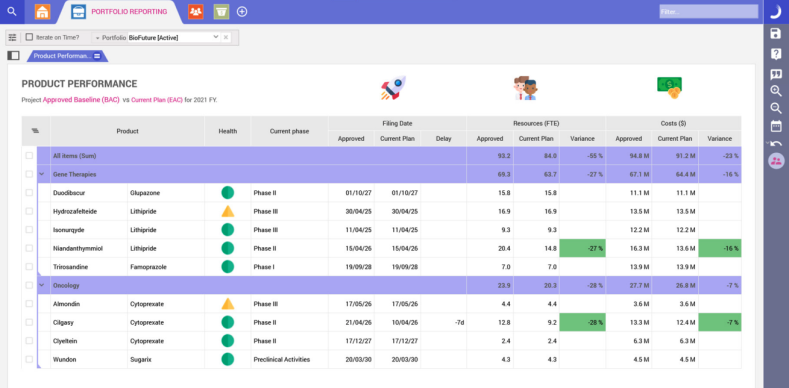
Portfolio health dashboard in Planisware
Strategic visibility and control
PPM gives you a centralized view of current and future projects, promoting better alignment and prioritization of projects with your overarching business plan.
It provides a systematic way of capturing and sharing information across project portfolios, providing decision-makers with the data they need to make smart, timely decisions throughout project lifecycles. You have real-time insights into costs, return on investment (ROI), resource allocation, and strategic impact.
To facilitate this, PPM software solutions give access to a range of clear, easy-to-read dashboards to visually represent all this data in one place. As well as improving accountability, this gives stakeholders access to (and trust in) your organization’s data.
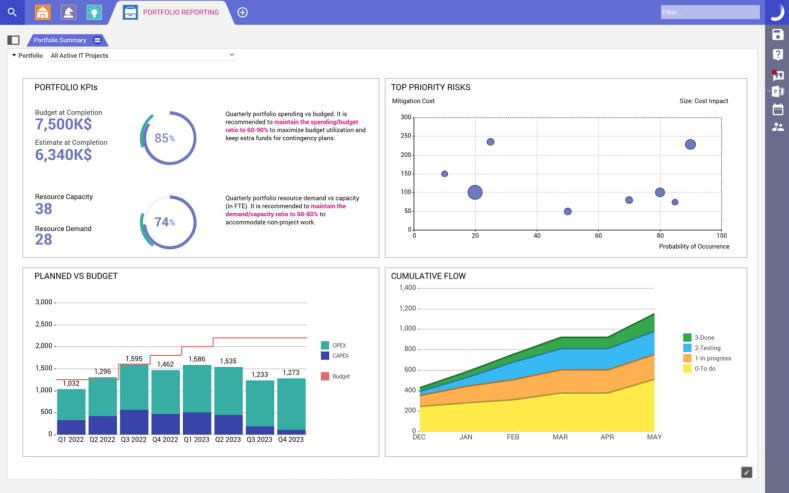
Portfolio overview dashboard
Operational efficiency and maturity
Day-to-day, implementing PPM can help your teams complete projects on time, in scope, and within budget. Taking things a step further, PPM software creates a single source of truth and includes a range of collaboration features which can improve information sharing and alignment across a project portfolio.
At a more organizational level, PPM builds transparency and good governance by tracking past, current, and forecasted work in real time. It leverages historical insights to optimize future project selection and resource allocation.
PPM also helps you align your organization’s best practices with its maturity level. Let’s say you are a rapidly-scaling mid-sized business. Rather than relying on simple ROI calculations, you may start to employ predictive AI analytics and “what-if” scenario planning to optimize your project portfolios.

Scenario comparison dashboard
Tailoring PPM to your priorities and objectives
Every organization deploys PPM differently. The approach you choose will be shaped by your business, your industry, and the initiatives and priorities that matter most to you.
If you are a corporate consumer goods organization, your PPM implementation may take on a more financial and strategic complexion. However, if you’re based in a highly-regulated industry, such as aerospace and defense, a PPM approach emphasizing resource and risk management may best suit you.
Your PPM implementation could focus on:
- Strategic alignment: This approach focuses on connecting your project portfolio’s execution to the organization’s vision—also known as strategic portfolio management (SPM). Essentially, projects will be evaluated based on their support for the broader business strategy. Effective SPM ensures investments and resources focus on the initiatives that drive your strategy forward, even as it evolves.
- Governance: A lack of standardization can slow things down, cause confusion, and waste resources. Governance-focused PPM aims at developing standardized processes, practices, and templates that everyone in the organization must follow. This ensures consistency, improves comparability, and helps create a more integrated business.
- Risk management: The objective here is to minimize risk exposure across an organization. Diversified projects and programs may be chosen, ensuring a mixture of stability with some managed risk. This approach may entail rigorous risk assessment frameworks to account for any potential disruption.
- Resource management: This approach emphasizes the importance of efficient deployment of finite resources, such as budget, time, and team members. This ensures resource allocation is highly precise and workloads are carefully balanced, avoiding bottlenecks while maximizing returns.
- Financial management: This focus ensures every portfolio is cost-effective and drives ROI. It is particularly beneficial for businesses relying on financial impact for its decision-making. It can be characterized by detailed modeling and forecasting for all projects and programs. It may also involve strict budget controls and kill switches for underperforming projects.
The process of adopting and integrating PPM can be broken down into five stages which we outline in more detail in our step-by-step guide on how to design and implement a PPM process.
How can software help with project portfolio management?
With a range of features and capabilities, PPM software empowers PMOs and leaders to execute all of their portfolio management duties, including:
- Demand management: PPM software can help you to collect, centralize, and process all of the proposals (or “demands”) that may impact your current or future projects. It helps you to assess their value and cost and ensure there is a connection between an expressed need and what is eventually implemented.
- Portfolio management: PPM solutions give you access to features that help you to formalize strategy, consolidate projects, identify constraints, and adjudicate between various different scenarios. This helps to avoid duplication and focus on those projects that add value.
- Project and product management: Features such as interactive Gantt charts, to-do-lists, and Kanban boards can facilitate day-to-day project planning. Templates can be used to standardize your best practices, and progress can be tracked by following milestones and deliverables.
- Resource management: By gaining real-time visibility into resource allocation and utilization across all projects, PPM tools help leaders to anticipate capacity, optimize workload, analyze time distribution, and gain insights on all activities—all in a single timesheet.
- Budget and cost management: PPM solutions can give you a centralized view of all your project costs, allowing you to anticipate, analyze, and manage your budgets, whether globally or with granularity.
Collaboration and reporting: PPM creates a central hub for past, ongoing, and forecasted project data, accessible to all relevant stakeholders in the business. This allows decision-makers to not only observe progress in real time, but anticipate problems and act with confidence.
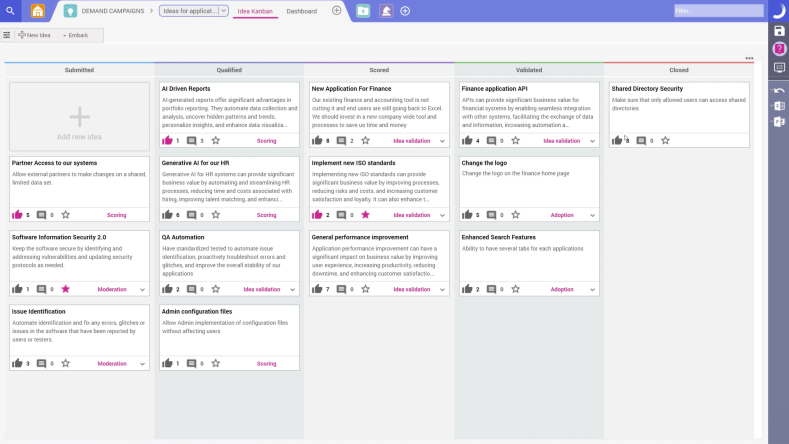
Demand management in Planisware Enterprise
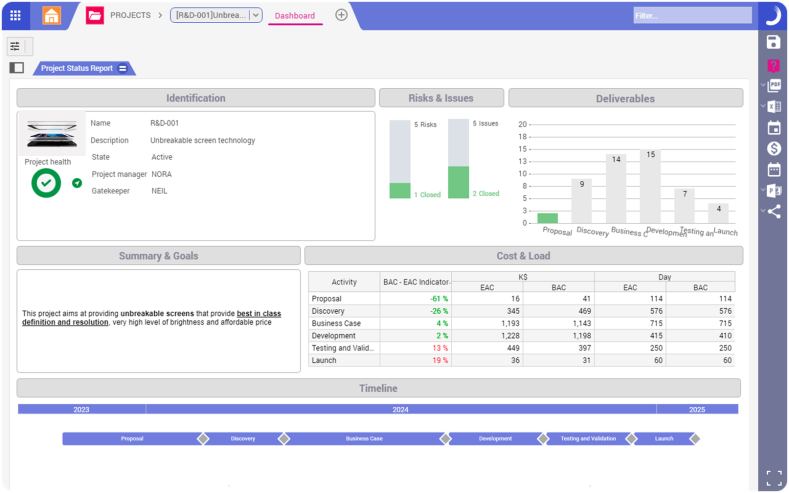
Project and product management
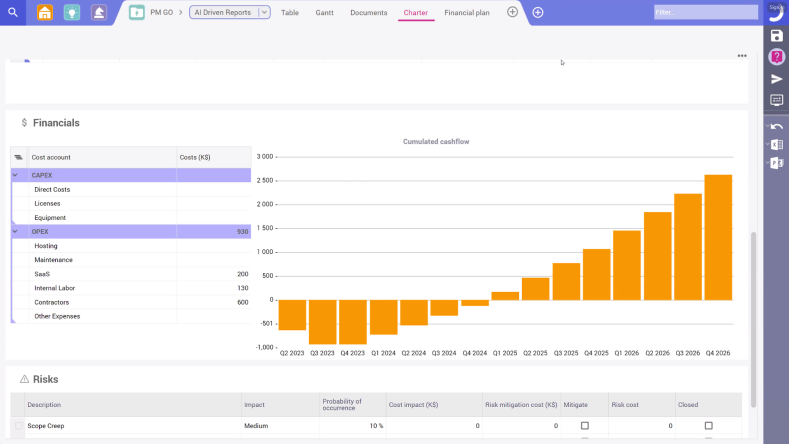
Budget and cost management
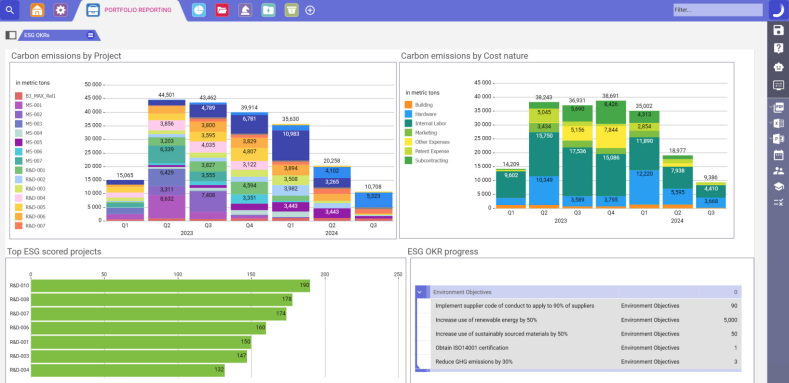
ESG OKR portfolio reporting
With innovative, industry-leading capabilities, Planisware is the trusted PPM software solution of global leaders including Ford, Nutrien, Airbus, Societe Generale, PepsiCo, and Philips.
Book a one-to-one demo to discover how Planisware can help you better manage your organization’s project portfolios and start driving maximum strategic value.